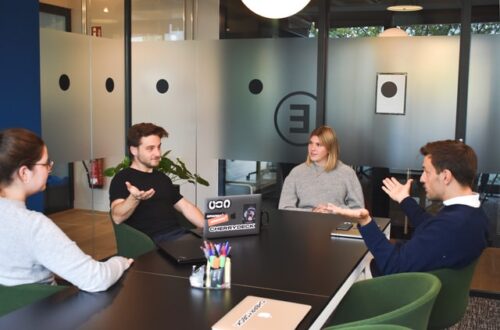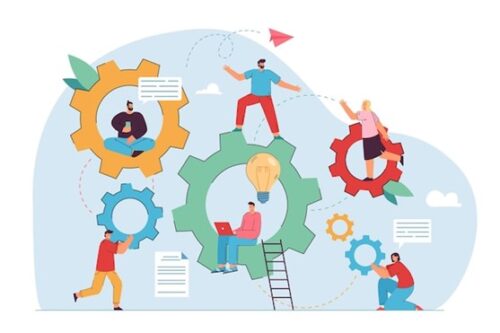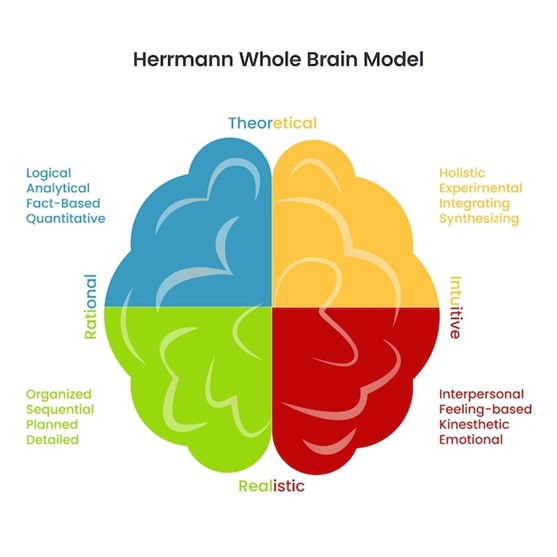The human brain is a complex and fascinating organ that has been the subject of study and exploration for centuries. One particular model that has gained significant attention in recent years is the HBDI Brain Model. HBDI stands for Herrmann Brain Dominance Instrument, and it offers a unique perspective on how our brains process information and make decisions. The HBDI Brain Model has many benefits and proves to be an invaluable tool for understanding the intricacies of our brains and how we process information. The human brain, with all its intricacies and mysteries, continues to captivate and intrigue researchers across various disciplines.
For centuries, it has been at the forefront of scientific inquiry, and one model in particular has garnered substantial interest in recent years – the HBDI Brain Model. The HBDI, short for Herrmann Brain Dominance Instrument, possesses a one-of-a-kind vantage point on the intricate workings of our brains and aids us in comprehending how information is processed and decisions are made. The benefits of the HBDI Brain Model are immense, as it provides us with valuable insights into our brain’s dominant thinking preferences and helps us optimize our decision-making process.
The HBDI Brain Model is based on the idea that each person has a preferred thinking style, represented by four quadrants: A, B, C, and D. Quadrant A represents analytical thinking, B represents practical thinking, C represents relational thinking, and D represents experimental thinking. By understanding our thinking preferences and those of others, we can enhance our communication, problem-solving, and decision-making abilities.
Understanding the Different Quadrants of the HBDI Brain Model
To fully harness the power of the HBDI Brain Model, it is essential to understand the characteristics of each quadrant. In Quadrant A, analytical thinkers excel at logical reasoning and prefer to analyze data and facts. They are systematic and methodical in their approach to problem-solving. Quadrant B represents practical thinkers who focus on realistic and tangible solutions. They are action-oriented and thrive in hands-on environments.
On the other hand, Quadrant C represents relational thinkers who prioritize social interactions and empathy. They excel at understanding others’ perspectives and building relationships. Finally, Quadrant D represents experimental thinkers who are innovative and thrive in unstructured situations. They are creative and enjoy taking risks to explore new possibilities.
By understanding these different thinking styles, we can appreciate the unique strengths and contributions that each quadrant brings to the table. It allows us to tailor our communication and collaboration strategies to effectively engage with individuals from all quadrants.
Benefits of Using the HBDI Model for Personal Development
One of the key benefits of using the HBDI Brain Model is its potential for personal development. By gaining insights into our thinking preferences, we can identify our areas of strength and areas that may require improvement. This self-awareness enables us to optimize our learning and growth by focusing on developing skills and competencies aligned with our preferred thinking styles.
Moreover, the HBDI Brain Model encourages us to embrace diversity of thought. By recognizing and appreciating the thinking preferences of others, we can foster a culture of inclusion and collaboration. This not only enhances our interpersonal skills but also expands our problem-solving capabilities by leveraging the diverse perspectives and approaches of others.
In essence, the HBDI Brain Model empowers individuals to become more effective and well-rounded thinkers, leading to personal growth and success in various aspects of life.
Applying the HBDI Model in the Workplace
The HBDI Brain Model has gained popularity in the corporate world as a powerful tool for enhancing communication, teamwork, and overall performance. By understanding the thinking preferences of team members, leaders can create a more inclusive and productive work environment.
One practical application of the HBDI Brain Model in the workplace is through communication games for team building. These games are designed to promote understanding and collaboration among team members from different quadrants. For example, a game called “Brainstorming Bonanza” can encourage individuals from Quadrant D to generate creative ideas, while individuals from Quadrant A can analyze and evaluate these ideas using their analytical thinking skills.
Another effective way to apply the HBDI Brain Model is through structured team discussions and decision-making processes. By ensuring that representatives from all quadrants are involved in the decision-making process, organizations can benefit from a more comprehensive evaluation of options and a higher likelihood of successful outcomes.
Communication Games for Team Building Using the HBDI Model
Engaging in communication games for team building can be an enjoyable and effective way to apply the principles of the HBDI Brain Model in a practical setting. These games not only foster teamwork but also enhance understanding and appreciation of different thinking styles. Here are three communication games for team building using the HBDI Brain Model:
- Four Quadrant Puzzle: Divide the team into four groups, each representing one quadrant. Provide each group with a puzzle piece that corresponds to their quadrant. The teams must collaborate to solve the puzzle by combining their pieces. This game emphasizes the importance of leveraging the strengths of each quadrant to achieve a common goal.
- Thinking Style Charades: Have team members act out scenarios that correspond to each thinking style. For example, a team member from Quadrant C can act out a situation that requires empathy and understanding. The other team members must guess the thinking style being portrayed. This game promotes understanding and empathy among team members.
- Quadrant Swap: Divide the team into pairs. Each pair consists of two individuals from different quadrants. The pairs must engage in a conversation where they take turns adopting the thinking style of their partner. This game encourages participants to step outside their comfort zones and appreciate different perspectives.
How the HBDI Model Enhances Communication and Collaboration
Effective communication and collaboration are crucial for success in any organization. The HBDI Brain Model provides a framework for understanding and maximizing these essential skills. By recognizing and adapting to the thinking preferences of others, individuals can communicate more effectively and foster a culture of collaboration.
For example, individuals from Quadrant A can learn to present their ideas in a way that appeals to the practical thinking of individuals from Quadrant B. Similarly, individuals from Quadrant D can collaborate with individuals from Quadrant C by considering the relational aspect of their ideas. By bridging the gaps between different thinking styles, the HBDI Brain Model facilitates more meaningful and productive interactions.
Furthermore, the HBDI Brain Model encourages active listening and empathy. By understanding the thinking preferences of others, individuals can tailor their communication styles to ensure that their messages are received and understood. This leads to clearer and more effective communication, minimizing misunderstandings and conflicts.
Exploring the Impact of the HBDI Model on Problem-solving and Decision-making
Problem-solving and decision-making are integral aspects of personal and professional life. The HBDI Brain Model offers valuable insights into how individuals approach these processes and suggests strategies for maximizing their effectiveness.
When faced with a problem or decision, individuals can leverage their preferred thinking style to generate innovative solutions. For example, individuals from Quadrant D may excel at thinking outside the box and exploring unconventional approaches, while individuals from Quadrant A may be more adept at analyzing and evaluating different options.
Moreover, the HBDI Brain Model emphasizes the importance of considering multiple perspectives. By involving individuals from all quadrants in problem-solving and decision-making processes, organizations can benefit from a more comprehensive evaluation of options and a higher likelihood of successful outcomes.
Success Stories of Individuals and Organizations Using the HBDI Model
Numerous individuals and organizations have experienced remarkable success by embracing the HBDI Brain Model. For instance, a multinational corporation implemented the HBDI Brain Model in its leadership development program, resulting in improved decision-making, enhanced collaboration, and increased employee engagement.
Additionally, individuals who have undergone HBDI Brain Model training have reported enhanced self-awareness, improved communication skills, and a greater ability to adapt to diverse work environments. These success stories serve as compelling evidence of the transformative power of the HBDI Brain Model.
Resources and Training Programs for Learning More about the HBDI Model
For those interested in delving deeper into the HBDI Model, there are various resources and training programs available. These resources provide valuable insights, case studies, and practical applications of the HBDI Brain Model. Some recommended resources include:
- Books: “The Whole Brain Business Book” by Ned Herrmann and “The Creative Brain” by Shelly Carson offer comprehensive explanations of the HBDI Brain Model and its applications.
- Online Courses: Several online platforms offer courses specifically focused on the HBDI Brain Model. These courses provide a structured learning experience and practical exercises to enhance understanding and application.
- Workshops and Seminars: Many consulting firms and training organizations offer workshops and seminars on the HBDI Brain Model. These interactive sessions provide an opportunity to learn from experts, engage in practical exercises, and network with like-minded individuals.
By investing in learning and development opportunities, individuals and organizations can unlock the full potential of the HBDI Model and reap its manifold benefits.
Conclusion: Benefits of HBDI Brain Model
The HBDI Brain Model offers a unique and powerful approach to understanding and harnessing the capabilities of the human brain. By recognizing and embracing the thinking preferences of ourselves and others, we can enhance our communication, collaboration, problem-solving, and decision-making skills.
Whether in personal or professional settings, the HBDI Brain Model has the potential to unleash our brain’s power for achieving success. By applying the principles of the HBDI Model and engaging in communication games for team building, we can foster a culture of inclusivity, innovation, and collaboration.
So, why wait? Embrace the HBDI Brain Model and embark on a journey of self-discovery, growth, and success. Unlock the full potential of your brain and unleash your true capabilities. The possibilities are endless!
Start your journey to unleashing your brain’s power with the HBDI Model today! Explore training programs, books, and workshops that will help you tap into your full potential. Invest in your personal and professional growth by embracing the HBDI Brain Model. Unleash the power of your brain and achieve success like never before! Contact us. WHS and Training Compliance Solutions offerinng Hermann Brain Dominance Instrument (HBDI) Consultation.












